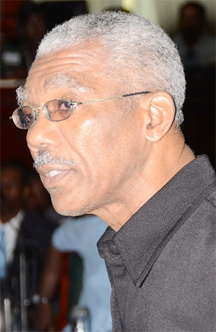Record world market prices have transformed Guyana’s gold-mining industry in several significant ways. Millions of dollars in new equipment by major local investors aimed at significantly increasing the volumes of gold extracted have occurred side by side with more modest investments by lesser investors who have found the gold industry to be a decidedly worthwhile alternative to the uncertainties associated with other less reliable investments. The lure of gold has also attracted hundreds of coastlanders – men and women. Jobs ranging from operating excavators to cooking in mining camps attract far better wages than anything that coastal employers can match.

Mining, even the more modest operations, has become a lucrative business. In 2011, for the third consecutive year, the industry topped 300,000 ounces. Even allowing for what the authorities believe is a high level of smuggling, with gold prices having remained at well over US$1,000 an ounce over the period and these days, heading for the US$2,000 an ounce mark, the returns to the miners coupled with the royalties accruing to the public treasury mean that, on the whole, gold is ‘good business’ for Guyana. So too it is for the expatriate mining companies, mostly Canadian that are finding their way to Guyana.
The government, too, has been paying an interest in the gold industry though there are those who argue that its interest remains limited to what it says is the impact of gold-mining on the environment. New, stringent regulations and the embrace environmental considerations have not only set the miners at odds with government but have also led to the view in some quarters that the new regulations are designed to force the closure of scores if not hundreds of small mining operations, leaving the industry to the bigger operators some of whom, interestingly, have only recently diversified into the sector.
Then there are the intrepid gold seekers from Brazil, who have exploited the absence of border controls to pour into the local goldfields, sometimes forming alliances with local miners to reap their own fortunes from the industry.
The transformation of the industry has been dramatic and the risks associated with ‘working gold’ in the interior now extend far beyond what used to be the major one – contracting malaria. Violence has reared its head in mining communities with a ferocity that lays bare the long-standing lack of official control over security in the interior as a whole. The violence, it appears, occurs at two levels. Incidents at mining camps, most of them usually associated with disputes over gold, frequently lead to confrontations that result in serious injury and death. There have been cases in which people have simply disappeared without a trace. The greater danger to the industry as a whole is posed by bands of well-organized and heavily-armed bandits, believed to be – in many cases – coastal criminals who have decided to cut themselves in for a share of the gold. They, too, are aware of the high price that gold fetches, and that, coupled with the circumstance of a far less protected vast interior has influenced their decision to turn their attention to targeting mining operations and miners on the whole.

The Guyana Gold and Diamond Miners Association (GGDMA) argues that improved interior security and, by extension, the creation of a more secure environment for gold-mining operations ought to have been an automatic official response to the growth of the gold-mining industry. This has not been the case and with the bandits now having asserted themselves, protection for the sector depends largely on the miners themselves. The challenge is both considerable and costly. Apart from armed attacks targeting mining camps and miners moving their gold from the interior to Georgetown, miners doing business in the city and the homes of miners have also been targeted.
The miners, it appears, are digging in. Guyana Gold and Diamond Miners (GGDMA) official Colin Sparman says that for all the enormity of the crime challenge, gold mining is attracting ever higher levels of investment and increasing numbers of people are opting for paid jobs in “the backdam”. What this means, Sparman says is that the miners have decided to “tough it out”.
For the bigger players in the mining sector the option of not quitting is a costly one. They must invest millions of dollars in the creation of elaborate security regimens, which range from protection in the form of trained and heavily-armed and officially sanctioned security details to the acquisition of costly electronic security equipment to secure both their homes and their mining operations in the interior.
Stabroek Business has learnt that the miners’ sizeable security forces include specialists recruited from abroad, personal bodyguards for high-profile investors and costly electronic equipment. Two service providers in the electronic security sector confirm that the most recent crime wave has been attended by a significant increase in security equipment and that the biggest buyers are miners. “In some instances purchases run into millions of dollars in a single instance of shopping,” an official at one of the Georgetown service providers told this newspaper.
These investments focus on both the protection of homes and offices as well as the monitoring of men working on dredges at interior locations. It appears that bandits apart, dredge owners also employ security equipment to monitor their own employees who are sometimes suspected of opportunistic stealing of gold.
With profits from gold-mining soaring, additional spending on security is a relatively modest investment for large-scale mining operations. For the smaller miners, however, the risks remain. Their protection comprises constant vigilance, practicing discretion by minimizing risks and, sometimes, setting up less costly security arrangements that employ persons with police and army experience and, this newspaper understands, weapons, not all of which are legally acquired.
Opposition Leader David Granger, who has made a number of public pronouncements on the weaknesses of hinterland security, told Stabroek Business that the protection of the country’s mining sector cannot be separated from improving hinterland security as a whole. Not for the first time Granger, a former Guyana Defence Force commander, points to the fact that while the E and F Divisions of the Guyana Police Force are responsible for interior security, the two divisions have been merged and are headquartered in Georgetown. This, he says, is an untenable situation that is far from indicative of a serious official determination to improve levels of security in the interior.
The retired Brigadier estimates that the Guyana Police Force is undermanned by at least 20 per cent. He points out too that it is in the interior mining locations, the desolate and unprotected trails and waterways that the bandits hold a decided advantage. The nature of the terrain, he says, requires that the force be equipped to fight crime by land, sea and air
GGDMA Consultant Edward Shields says he too has heard of the owners of local mining operators recruiting security personnel from overseas. He is not surprised. It is, he believes, an inevitable consequence of the failure on the part of the authorities to take measures to improve hinterland security not only for the sake of interior communities as a whole but also as a response to the growing importance of the gold-mining sector. The miners, he says, have “definitely decided that they have to raise their game.” Shields says he is aware that the crime situation has caused the larger mining operations to pay greater attention to security. Meanwhile, he points out that the government’s declared intention not to facilitate the profligate granting of gun licenses, the policy of self-help among the miners may have given rise to an increase in the number of unlicensed weapons to which both miners and bandits have access.
Both the mining and forestry sectors are represented on a hinterland security oversight committee, headed by the Commissioner of Police and concerned with fielding suggestions for improving interior security. Both Granger and Shields believe, however, that significantly improving interior security requires commitments to investment which cannot be made at the level of this forum. Granger insists that whatever initiatives the miners may take on their own to protect themselves and their property, government must undertake the wider responsibility, which, apart from recognizing the importance of protecting a valuable local industry, also takes account of hinterland security as a substantive state responsibility.
Shields concurs, pointing out that investment in security by private operators is likely to grow even more with the imminent increased activity in the sector by foreign – mostly Canadian investors. “Security will clearly become a bigger issue as these investments come on stream and the government will be expected to play a bigger part in helping to protect the industry,” Shields says.




